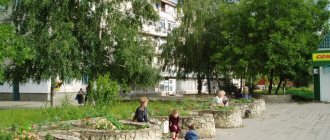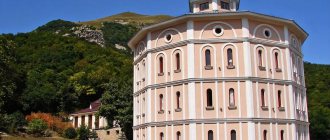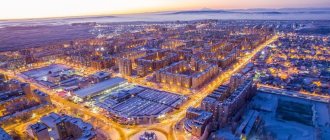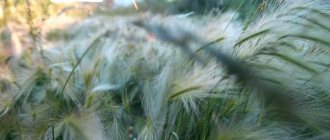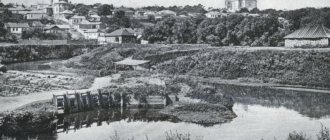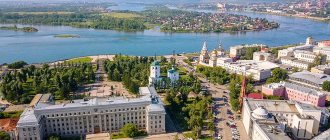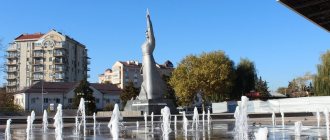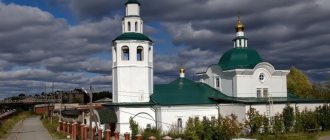The city of Kislovodsk is located in the Stavropol Territory. This is the southernmost of the resort towns of the Caucasian Mineral Waters. It is located 38 km southwest of Pyatigorsk, 21 km from Essentuki and 64 km from the Mineralnye Vody station of the North Caucasus Railway. Population - 149.496 thousand people (2009), area - 71.83 sq. km. The number of sunny days per year in Kislovodsk is almost twice as large as in Pyatigorsk or Essentuki. The foundation and name of the city is associated with the source of acidic mineral water Narzan. Bogatyrskaya water is how “nart sane” is translated from Turkic.
Foundation of the city
The first description of narzan was found in the notes of the chemist J. Reinegs in 1784. In 1793, academician, traveler and zoologist Peter-Simon Pallas explored the sour spring and compiled a description of the Narzan spring. According to the testimony of other travelers, baths for bathing in Narzan were carved out of stone near the main spring. One of them stands as an ancient monument near the building of the resort museum. The founding date of the resort is considered to be 1803, when the Emperor issued a decree recognizing the city of Kislovodsk and the entire region of the Caucasian Mineral Waters as a healing area of national importance. In 1808–1809, the first official visit by patients to the resort took place.
Kislovodsk Airport
There is an airport in Kislovodsk that has ceased operations. The nearest operating airport is in the city of Mineralnye Vody. The distance from Kislovodsk to the airfield is 53 km. The airport has the status of a federal facility and is the largest airfield in the Stavropol Territory and the North Caucasus Federal District. Airport type: civil. It works every day around the clock.
The airport serves aircraft of major Russian and foreign airlines: Yakutia, UTair, Aeroflot, FlyDubai, S7 Airlines, Nordwind Airlines. Popular destinations of regular and charter flights: Dubai, Moscow, Rostov-on-Don, Istanbul, St. Petersburg. The annual passenger traffic is more than 2.4 million people.
Story
In 1822, a restaurant with a colonnade and a wide staircase descending to the park and to the spring was built, as well as a grotto (now Lermontovsky) and a Kursaal (now a theater). A hotel and resort park are under construction. There are many places in Kislovodsk associated with the name of M.Yu. Lermontov. Composer M. Glinka and artist N. Yaroshenko were treated here. In 1848–1858 the Narzan Gallery appeared. With the construction of the highway and railway from Mineralnye Vody to the resort, the number of patients coming here is also increasing. At the end of the 19th century, a mineral water bottling plant was opened, and additional resort buildings were built. At the beginning of the century, intensive construction of hotels and dachas was underway. Kislovodsk received city status in 1903. During the First World War, the resort became a hospital for the wounded. After the revolution, the resort developed intensively. 20 new sanatoriums were built and 22 sanatoriums were established on the basis of private dachas. New deposits of healing waters were discovered. A mud bath with silt sulfide mud from Lake Tambukan was built. The resort, damaged during the Great Patriotic War, was restored by the early 50s. The resort was expanded, which became the country's hospital base and was awarded the Order of the Great Patriotic War, 1st degree. City Day is celebrated on the second Saturday of September.
CAUCASIAN MINERAL WATER
The official history of Kislovodsk began in 1803.
On March 7, 1803, a rescript from Alexander I was issued on the construction of a fortification in a place “where the acidic waters are located near the Caucasus Mountains.” It instructed the inspector of the Caucasian Line, Prince P. D. Tsitsianov, to “bring this fortification into action, using military servants.” The Kislye Vody fortress, belonging to the Azov-Mozdok defensive line, was erected on a hill between the rivers, which later received the names Olkhovka and Berezovka, at a cannon shot’s distance from the Narzan source. Construction was carried out by six companies of the 16th Jaeger Regiment from the Konstantinogorsk Fortress from June to October 1803.
The fortress, surrounded by a moat, had the shape of a Sternshanz star with three acute-angled and two semicircular bastions on which cannons were placed. Gates led into the fortress from the north and southwest. On the territory of the fortress there were three officers' houses, three soldiers' barracks, a provisions point, a guardhouse, kitchens, an infirmary, company training facilities, a powder magazine, a stable, and houses with services for vacationers. An underground passage was dug from the fortress to the river in case of a long siege. On the hill opposite the source, a Cossack redoubt with a barracks was built. Usually there were two companies of soldiers in the fortress, but in the summer the garrison was replenished with two more companies of infantry, several dragoon squadrons and a hundred Cossacks. The garrison of the redoubt on Cossack Hill was also strengthened, pickets were deployed, and batteries were installed on the nearest hills. The names of small mountains – Cossack, Piketnaya, Batareynaya – now remind us of the events of that time.
The founders and first inhabitants of Kislovodsk were Russian soldiers, who, after serving their assigned time in the fortress, remained to live here. Not far from the fortress, on the slopes of the hill, now called Soldatskaya, they built turf and adobe houses, covered with reeds or straw, often for 2-3 families. The first streets were the 1st and 2nd Soldatskie and Kabardinskaya streets (after the name of the Kabardian regiment, whose soldiers participated in the reconstruction of the fortress). This is how the Kislovodsk Soldiers' Settlement arose. The Russian population of modern Kislovodsk also came from the Slobozhans.
In the summer, more and more holidaymakers visited the Kislovodsk spring. In 1812, a bathhouse with 3 baths was built (before that, narzan baths were taken in depressions dug in the ground). In 1820, during his first trip to the Caucasus, A.S. Pushkin lived in the Kislovodsk fortress, who arrived with the family of General N.N. Raevsky. Pushkin visited Kislovodsk for the second time in the summer of 1829 during his second trip to the Caucasus; this time the poet first settled in a restaurant, and then moved to the house of A. F. Rebrov.
General A.P. Ermolov played a special role in the formation and development of Kislovodsk, thanks to whom the front edge of the Caucasian line was moved much further south and the raids of the highlanders stopped. According to his personal proposal, in 1822 the government allocated funds for the improvement of the city, in particular, according to the design of the Bernardazzi brothers, a 2-story restaurant, luxurious for that time, with a colonnade and a staircase descending to the park and to the source, was built above the source. A grotto (now Lermontovsky) was built under the stairs. The restaurant had a large hall for dances, balls, as well as rooms for visitors. In addition, in 1823, by order of General Ermolov, work began on the development of the Kislovodsk park.
In the middle of the 19th century, the Kislovodsk fortress was rebuilt according to the design of the architect S.I. Upton. Among Upton's other buildings, one should first of all mention the stone building of the Narzan Gallery in the medieval English style, the construction of which lasted 10 years and ended in 1858. By 1873, Kislovodsk was already well landscaped: from the turn of the road straight to the gallery there was an alley of pyramidal poplars. Behind the gallery there was a vast and dense park. To the left of the gallery are the houses of private owners. At the end of the park, on the right side of the river, there was a bathhouse built over a cold spring called Semigradusny. Now in this place one of the attractions of Kislovodsk is a mirror pond with a Glass stream.
Famous merchant and noble families and representatives of the capital's intelligentsia began to settle in Kislovodsk: landowner Alexei Rebrov (M. Yu. Lermontov and L. N. Tolstoy visited his famous house), naval general Joseph Debu, Astrakhan merchant, and then mayor Nikolai Shaikin , Ekaterinodar merchants brothers Tarasov, etc. The population of Kislovodsk grew rapidly, in 10 years, from 1881 to 1891, it grew from 1551 to 6000 people.
Of great importance was the construction of the highway from Mineralnye Vody station to Kislovodsk in 1875 and especially the construction of the railway line from Mineralnye Vody in 1893, through which the city was connected with the central cities of the country. This immediately increased the number of visitors, which required increased housing construction and increased water supply. In 1895, Kislovodsk received electric lighting from the Bely Ugol hydroelectric station. In 1896, a small mineral water bottling plant was opened.
In 1895, construction of the Kursaal was completed. Nearby, in the same year, the construction of a light openwork station building was completed, which, together with the Kurhaus, represents a single architectural ensemble. These beautiful buildings are a monument of old architecture. At one time, the Russian writer D.N. Mamin-Sibiryak wrote about Kislovodsk: “A wonderful city, spreading its streets along the steep banks of the river. The general appearance was very beautiful, and the magnificent station could decorate any capital.” Currently, the railway station has been restored, and opposite the old building a new station building has been built, erected in style and harmony with the existing one and being, as it were, a mirror image of the old building, but with spacious platforms, a ticket office, and a storage room.
In 1825, four miles north of the Kislovodsk fortress, the village of Kislovodsk was founded. The first residents of the village were 100 families resettled here from the village of Aleksandrovskaya in the spring of 1826. The Cossacks, engaged in arable farming and cattle breeding in their free time, supplied the resort and settlement with food. There was an administration of the ataman, who disposed of the stanitsa lands, farmland, forests and social capital. There were two Christian communities in the village: Orthodox and Old Believers.
In 1832, the village entered the formed Caucasian linear Cossack army, and in 1860 - into the Terek Cossack army, formed from the Caucasian linear army. Since the mid-50s of the 19th century, the number of Ukrainians in the village has increased. This was the second wave of migrants, when people from the Voronezh, Poltava, Tambov provinces, Ukraine, Don and Khopr arrived in the village. In the second half of the 19th century, 1.5 thousand inhabitants lived in the village.
At the beginning of the twentieth century, the Kislovodsk village was one of the medium-sized villages in the region. From 2.5 to 4.4 thousand people lived in it. The village atamans were I. Smirnov, I. Vasyuk, A. Chepko, N. Tribukhin, N. Kuzmenko. The Cossack administration was located on the village square (now the traffic police administration, corner of Tchaikovsky and Essentukskaya streets). On the initiative of Ataman Chepko, a village school was built in 1906 (now secondary school No. 9).
The Kislovodsk village existed as an independent administrative unit until November 23, 1959, when, by Decree of the Presidium of the Supreme Soviet of the RSFSR, it was included within the city, and state farms, collective farms and subsidiary farms of the former village were transferred to the Predgorny district of the Stavropol Territory.
In 1903, Kislovodskaya Sloboda received city status. Near the Kurhaus in the Upper Park, a beautiful musical shell was built, called crystal for its high acoustic properties. In 1920 - 1930 20 new sanatoriums were created in the city.
In 1928, according to the design of the architect P. P. Eskov, in the central part of the city, next to the Main Narzan Baths, the October Baths building with 60 cabins was built, which was distinguished by noble external forms, amenities, a compact internal layout, an abundance of air and light and had a Narzan storage facility with the volume 400 cubic meters. In the same year, the old Narzan bottling plant was rebuilt and mechanized. At the Fortress sanatorium, a mud bath was built in 1934, which provided silt sulfide mud from Lake Tambukan to all patients coming to the resort (capacity - up to 300 patients). In 1935 - 1938 In Kislovodsk, wonderful sanatoriums came into operation, such as the Sergo Ordzhonikidze sanatorium with 500 beds, built according to the design of architects M. Ya. Ginzburg, Popov, Vakhtangov and Shpalek, which to this day remains one of the most comfortable health resorts in the resort. During the same period, according to the design of the architect M. I. Merzhanov, the NKVD Sanatorium-Hotel (now Kislovodsk) and the Red Stones sanatorium, distinguished by luxury and maximum amenities, were built.
All 20 sanatoriums built in Kislovodsk before the Great Patriotic War were built in compliance with high sanitary requirements and with maximum comfort for patients. The external forms of the buildings are modern, the areas are landscaped and adapted for relaxation and treatment. They still serve the people today. The sanatorium buildings are architectural monuments of Russian architecture of the 1930s. After the outbreak of the Great Patriotic War, further development of the resort was disrupted; Kislovodsk was turned into a hospital base. Already in August 1941, 36 hospitals were established on the basis of sanatoriums, boarding houses and hotels. The city of Kislovodsk for its great dedicated work in treating and restoring the health of soldiers, a significant contribution to the development of healthcare and for the successes achieved in economic and cultural construction, was awarded the Order of the Patriotic War, 1st degree.
By 1950, all the sanatoriums and medical institutions of the resort were completely restored, and extensive hydrogeological surveys were carried out, which made it possible to increase the reserves of Narzan for balneological purposes. Along with the restoration work, new construction and improvement of the city began. According to the design of the architect A. A. Ol, the first-class sanatoriums “Mountain Peaks” and “Piket” were built in 1951 and put into operation. In 1952, the “Mountain Air” sanatorium, built in a palace style, and the “Moscow” sanatorium came into operation. In 1955, the collective farm “Russia” in the Novoaleksandrovsky district of the Stavropol Territory built a wonderful sanatorium “Kolos” for collective farmers. All new health resorts were equipped with modern equipment and created maximum comfort for patients. The state spent more than 600 million rubles on the development of the resort, its restoration, reconstruction and improvement.
Modern Kislovodsk has a high degree of improvement and is one of the greenest cities in the South of Russia. Today the city is a single resort complex with developed infrastructure. There are 55 sanatoriums and boarding houses, a hotel complex, a resort clinic, and a mud bath in the city.
The population is about 130 thousand people.
The resort's capacity in 2014 was 278,611 people. According to this indicator, Kislovodsk has remained a leader for many years in comparison with other Kavminvod resorts.
Treatment profile
For the Kislovodsk resort, which has carbon dioxide mineral waters, a climate and landscape typical of the middle mountains, diseases are shown in accordance with the main profiles of the resort:
- diseases of the circulatory system - conditions after rheumatic endomyocarditis;
- myocarditis (6-8 months after an exacerbation of the disease) in the absence of process activity, with circulatory failure no higher than grade I or without it, without unfavorable prognostic heart rhythm disturbances, which include polytopic, frequent, group early extrasystoles, paroxysmal cardiac disturbances rhythm, atrial fibrillation, etc., as well as conduction dysfunction (atrioventricular block above grade I);
- heart defects - mitral valve insufficiency;
- combined mitral heart disease with a predominance of mitral valve insufficiency;
- condition after commissurotomy (not earlier than 6-8 months after surgery) without signs of activity of the rheumatic process, in the absence of insufficiency and insufficient blood circulation not exceeding degree I, in the absence of prognostically unfavorable disturbances of heart rhythm and conduction (atrioventricular block above degree I, double fascicular block in His bundle system);
- coronary heart disease with rare attacks of angina (functional classes 1-11), without prognostically unfavorable disturbances of heart rhythm and conduction, with circulatory failure no higher than grade 1;
- hypertension stages 1-11;
- hypotension;
- diseases of the nervous system - neuroses with a predominant dysfunction of the cardiovascular system;
- atherosclerosis of cerebral vessels without cerebrovascular accidents, as well as 3-4 or more months after transient mild to moderate cerebrovascular accidents;
- nonspecific respiratory diseases outside the period of exacerbation, with pulmonary vascular insufficiency not exceeding stage I.
Mineral water
The wealth of the Kislovodsk resort is the Narzans. As a result of many years of various studies, a modern understanding of the conditions for the formation and release of carbon dioxide water to the surface in the area called the “Kislovodsk Narzan deposit” has emerged.
We find the first official description of the Kislovodsk springs in the notes of Peter I’s physician Gottlieb Schober, a member of the Academy of Sciences in St. Petersburg, which mentioned a “fairly sour spring” in the Pyatigorye region. “It’s a pity that in Russia they manage the gifts of nature so poorly. Millions of liters of healing water are poured here, and Russians travel to Europe,” wrote P. S. Pallas, a member of the St. Petersburg Academy of Sciences, who in 1773 gave the first detailed description of the Narzan spring.
F.P. Haaz (1810) wrote: “Anyone who does not have detailed information about these waters will be prejudiced in their favor when he hears about the respect that their previous owners, the Circassians, had for them. They called this source in their language heroic water or alcohol (narzana - “nar” means hero, hero, and “zana” means alcohol).”
The legend tells about the brave Nart Arefa, who courageously fought against his enemies, but in one of the battles he was very seriously wounded. He reached the Hot Waters and began to bathe in them: the wounds healed, but he did not feel his real strength. One elder told Aref about the miraculous spring “Nartsan” - a heroic drink in the mountains in the south. Aref rode his horse all day and in the evening he entered a valley surrounded by mountains, where a powerful spring of mineral water flowed. Aref Narzan got drunk and his former strength returned to him.
Initially, vacationers drank and swam in the so-called main Narzan, which came out of the ground in the valley of the Olkhovka (Kozody) River. This is cold (13.8°C) carbon dioxide bicarbonate-sulfate-calcium water, the content of free carbon dioxide in it is 1.7 g, the sum of dense components is 2.3 g per 1 liter.
Until 1928 Narzan was the only mineral spring in Kislovodsk. Subsequently, the Kislovodsk Narzan deposit expanded significantly both due to the release of a number of new abundant and valuable mineral waters in Kislovodsk itself, and as a result of successful exploration and capture of new mineral waters in the valleys of the Berezovka, Olkhovka and Podkumka rivers. The first is located 8 km south of the resort center, the other two are located on the outskirts of Kislovodsk and, in essence, are part of the Kislovodsk deposit. Kislovodsk Narzans belong to the balneological group of carbonic waters and differ from each other only in the amount of mineralization and the ratio of the main ions, which allows us to define three main groups in them.
The first group includes the Narzan spring, well 5/0-bis, as well as the waters of the Berezovsky and Podkumsky areas. Low-mineralized (about 2 g/l) waters of this group are characterized by a sulfate-hydrocarbonate magnesium-calcium ion-salt composition with a variable content of sodium ions, carbon dioxide content - up to 1.0 g/l, temperature 12°C. The main narzan is used mainly for external procedures.
An important role in the development of the resort and the planning of resort construction was played by the construction of a mineral pipeline through which carbon dioxide waters (narzans) from the Kumskoye deposit (the village of Krasny Vostok, 43 km from Kislovodsk) are supplied to Kislovodsk. In terms of ionic-salt composition and degree of mineralization (7.8 g/l), the Kuma Narzans are close to the Pyatigorsk hot Narzans, differing from them in their lower sulfate content. The concentration of carbon dioxide in them is about 1.5 g/l. These waters are cold and ferruginous. In undiluted form they are used for drinking purposes, and when mixed with the waters of the central Kislovodsk (Narzan spring, well 5/0 and partially 5/0-bis) and Berezovsky (well 7-B-bns) areas - for balneotherapy.
The total flow rate of Kislovodsk sources and water coming from the Kumskoye field is 3767 cubic meters/day (operational and prospective reserves approved by the State Reserves Committee).
The second group is formed by waters of the Dolomite Narzan type (well No. 7.5/0.12), which differ from the waters of the first group by greater mineralization (about 5.0 g/l), including due to an increase in the concentration of sodium and chlorine ions, and high carbon dioxide content (more than 2.0 g/l). They are used for medicinal drinking purposes and are connected to the pump rooms of the Narzan Gallery (well No. 7) and the Round Pump Room (wells No. 5/0 and 12).
The third group combines waters like Sulfate Narzan with a mineralization of 5.2-6.7 g/l, mainly due to a higher concentration of magnesium and sodium sulfates. Sulfate narzans were first discovered by a well drilled in 1934 at a depth of 169 m.
The presence of small amounts of arsenic, as well as active iron up to 15 mg/l, as well as trace elements (boron, zinc, manganese and strontium) is of considerable medicinal importance. All these qualities make sulfate narzans especially valuable waters for drinking treatment. Narzan sulfate increases gastric secretion, improves digestion, improves biliary function of the liver, reduces bloating, and regulates intestinal function.
Carbon dioxide waters of the Podkumsky and Olkhovsky areas (wells Nos. 5-NP, 115-E, 115-bis) also belong to the sulfate type, but unlike the latter, in them sodium sulfates predominate over magnesium sulfates. The water from source No. 5-NP is supplied to the People's Pump Room (Alikonovskaya Balka), and wells No. 115-E and 115-bis are supplied to the Sosnovy Bor and Raduga sanatoriums.
Equipped mineral springs, pump rooms:
- Pump room Zhelyabovsky - st. Kirova, 3 (Zhelyabova St.);
- New (round) pump room - Kurortny Boulevard (corner of Vokzalnaya Street);
- Narzan Gallery - Kurortny Boulevard, 19.
City information
Kislovodsk is the administrative center of the municipal entity of the same name in the Stavropol Territory. Located in the southwest of the Russian Federation. It is a resort town. This is facilitated by mineral water sources, mild climate, and picturesque landscapes. The economy is represented by retail trade, services provided to vacationers, and food industry enterprises.
There is a sanatorium infrastructure. The A157 highway runs through the settlement. There is a railway station of the same name. There are secondary specialized and higher educational institutions and their branches.
My tips for Kislovodsk
Visiting Kislovodsk on your own is a great idea for those who dream of a holiday with Khychin and a glass of Narzan with a view of the mountains.
People come here to relax with children and alone, young and old. In summer you can enjoy green meadows and barbecue, and in winter you can spend weekends in a relatively warm climate and go skiing.
With a little less responsibility than the indigenous people, but still with knowledge of the matter, I can advise you to come and enjoy life here. At first glance, the “old man’s resort” will captivate even the young. Yes, you won’t find clubs here, but yoga classes on the Podkumka hills on fresh green grass or a picnic on Pervomayskaya Polyana will replenish your resources and make you come back. Advice: if you go to Podkumok by train, put away your phone and look out the window. You can see plateaus and glaciers.
Where should a tourist stay?
There are many places to relax in the city. Where it is better to live in Kislovodsk is up to you and your budget. You will be offered to rent an apartment as soon as you get off the train/train at the station. By the way, the station is one of the most beautiful I have seen. It was built in pre-revolutionary times, so it retained the bohemian charm of those years. You can see how ladies and gentlemen of past centuries emerge from the locomotive, inhaling the aromas of the resort.
So, let's get to the point. In Kislovodsk:
- You can search for apartments for daily rent in a more reliable way on Sutochno.ru (with reviews and photos)
- Hotels are booked on Booking.com
- Tours to sanatoriums* - to improve your health - are selected on Sanatory.ru *my aunt highly recommends 4* Plaza and Healing Narzan, but the price tag, of course, is worthy
If you are looking for an apartment or a hostel, I recommend renting a room in an old building near the mosque. There are several authentic houses in Armenian and Georgian style. It’s very nice to walk around such a lively area. It’s convenient to live there, everything you need is nearby and not as expensive as on Resort Boulevard.
Where to eat in Kislovodsk?
Where to go to eat in Kislovodsk? Eating is a favorite pastime in the South. Everything is delicious, fresh, juicy! I'll break it all down:
1. Street food and shops Please pass by McDonald's and KFC. Don't offend the locals. Their street food is much tastier. Khychins, shawarma, Ossetian pies are at almost every turn here. You can even buy fresh pita bread in a store near your home. Fruits, vegetables - all first freshness. White peaches are especially delicious here. They are brought from Armenia and Azerbaijan. You have never tasted such juicy peaches anywhere, no doubt about it!
During this time, my favorite fast food cafes, of course, appeared. This is Habibi near the old post office and Jerusalem Shaverma in the market. Get ready, there is no card payment at Jerusalem Shawarma. But everything is inexpensive, less than 200 rubles. And Habibi also has pizza. The best in Kislovodsk!
2. Restaurants and cafes I love the restaurant in Kislovodsk - Khinkali Kaifovali. Service, smiling staff, caring owner, interior, Georgian music and food! And all this for modest money. The average bill per person, including drinks, is 500-800 rubles. In short, this is a non-pretentious, cozy establishment that has soul. There is no premium for the view or crowds of tourists. Stop by if you want to try some real delicious local cuisine. Just call in advance, tables are selling like cakes.
Less memorable, but also good restaurants on Kurortny Boulevard:
— Height 5642 — expensive, beautiful interiors, if you need to impress your girlfriend/wife, this is it. — Ogonek — very close to the Height; more suitable for ladies and gentlemen. — Lamb — Georgian cuisine is always good. — Donuts in Snezhinka — don’t forget about them!
3. Attention, bonus! Well, in reserve - for the most attentive and those who read texts to the end :) - I will leave one more cool place.
Write a comment on this article: for example, why Kislovodsk? Or maybe you know/heard about places that I didn’t mention in the text? And in return, I will send you by email the name of a fashionable Kislovodsk restobar - with hookah, live music, dancing and wonderful local cuisine.
How to get there from the airport?
There are several ways to get from the airport to Kislovodsk. But the airport is located in the town of Mineralnye Vody. And although it is part of the CMS, the rest of the cities do not seem to like it. There are no sanatoriums, attractions or high mountains in it. Actually, because of the relatively flat landscape (which may not seem like it to a resident of Moscow), the airport was built here.
So, our options:
- Electric train. There is a direct train from Mineralnye Vody to Kislovodsk. It's funny (not) that they start walking late and finish work too early. You will not leave before 5am or later than 9pm. This pleasure costs 184 rubles.
- Buses in the Caucasus are a special story. These are such mythological creatures that many locals don't know where to look for them. Therefore, I won’t even recommend it. During my entire stay I never used them. I don't recommend it to you either. By the way, city minibuses and buses are also peculiar birds. Catching a minibus after 7 pm is a great success.
- Taxi. I used the airport 4 times and preferred to take a taxi. If there are two or three of you, don’t even think about it. Definitely a taxi. 800-1000 rubles and you are in Kislovodsk. While the cost of a bus and train will be the same, but there will be much less amenities. And if you go at dawn, you will also be stunned by the views. Just like that.
Unspoken anthem
Ah, Kislovodsk, my love, City of the sun, living water, Blue mountains, unearthly beauty, Hello, gray Elbrus, Hello, native city, Kislovodsk, we are on friendly terms with you. I remember every dream - in Kislovodsk with you, the wonderful air was intoxicating, your tender gaze beckoned. We will sing this song again.
Ah, Kislovodsk, my love! I see a fairy-tale world here. Oh, you are my Valley of Roses, I am always in your captivity.
By the pond in the hour of parting, we vowed to love the Caucasus. And the coin has long since sunk to the bottom, Inviting us once again And again for the umpteenth time I meet you, Caucasus. And again I'm in love And again I have a dream, How we walk through the park together
Ah, Kislovodsk, my love! I see a fairy-tale world here. Oh, you are my Valley of Roses, I am always in your captivity.
Words and music by Karina and Margarita Talverdiev, performer - V. Eremenko.
What is worth seeing in 1 day in Kislovodsk?
Kislovodsk is small, but the pride of the Stavropol region. The lion's share of its entire area is occupied by... the park. This is both the main attraction, and a place of rest for Kislovodsk residents themselves, and a concentration of cafes and restaurants.
A route around Kislovodsk for 1 day will not be replete with all the natural attractions that exist in the region - it would only cover one park! - but you will be able to get acquainted with the cultural part of the resort.
I will give you a convenient route around the park - it includes all the iconic places of the city. If desired, it can be diluted with an excursion, so that you have someone to ask the most pressing questions: “What are the salaries in the region?” and “what kind of building is this?”:
- Tripster - here are good sightseeing tours, both simple walking ones for 700 rubles, and original sightseeing tours only for your company.
- Sputnik8 - and here are trips to the Bermamyt plateau, Djily-Su and all other incredible places, which I will tell you about below.
The guide will expand your stock of information about the city so much that you can then competently write articles on the topic of what to see in Kislovodsk on your own
